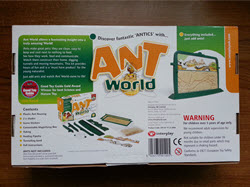 A close look into the world of ants using an ant kit! I have to admit to having a fascination with ants all my life, so it was an easy call to take a look at what ant kits there are out there, how they are best used and how they allow you to observe living ants.
A close look into the world of ants using an ant kit! I have to admit to having a fascination with ants all my life, so it was an easy call to take a look at what ant kits there are out there, how they are best used and how they allow you to observe living ants.
It makes sense to also look at the longevity of kits like this – do they provide a good means of supporting ants over a longer period of time, or are they just short-lived projects? I’m presuming at the time of writing this that queen ants are not provided [note: actually I’ve discovered that some do, see my reviews] or that you will not be told to start digging up ant nests to get one as clearly, you will destroy a colony.
As I say, at this stage I actually don’t know so I will find out what the various kits provide and how they go about making a living colony.
There’s quite a range of kits on the market with prices from around £6 / $10 to a hefty £50 / $85.
The ant kits appear to use a sand, sand/clay substrate for the ‘soil’ or a clear gel. Every ant kit came with a display housing of some sort, many having the means of joining up more housing with standard-sized clear tubing – so you can expand your ant empire.
Some kits come with ants, a few also come with a queen. Some have the option to buy in ants or are given a coupon to get ‘free’ ants. Some rely upon you collecting ants yourself which raises some interesting questions in itself.
Ant Kit Reviews
 So let’s start off the reviews with Ant World from Interplay. This ant kit appears only to be available in the UK, so apologies to US visitors (there are plenty of others available though) and ants are encouraged to be collected yourself from the garden.
So let’s start off the reviews with Ant World from Interplay. This ant kit appears only to be available in the UK, so apologies to US visitors (there are plenty of others available though) and ants are encouraged to be collected yourself from the garden.
However, if you don’t have a convenient garden, or don’t want to collect ants, there is an ordering service available. Click here for the Ant World review.
